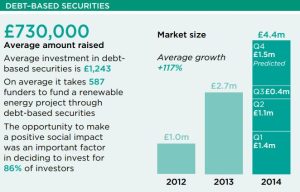What are Debt Based Securities? Lenders receive a non– collateralized debt obligation typically paid back over an extended period of time. Similar in structure to purchasing a bond, but with different rights and obligations.

The debt–based securities market grew by 63 per cent in 2014 Online debt–based securities in renewable energy projects grew by 63 per cent in 2014 to £4.4 million in total financing. The average deal size for debt–based securities is £730,000. On average, it takes 587 investors to fund a renewable energy project through debt–based securities with an average investment amount of £1,243.
The survey of 384 investors in debt–based securities shows that they in general invest relatively large amounts. Sixty– two per cent had invested more than £500 with 21 per cent having invested more than £5,000. They tended to invest in single or very few projects with a third having made only one investment and half less than three investments.
This finding however must be reconciled by the fact that debt–based securities is a relatively new model of alternative finance and only a small amount of deals have been offered and funded to date. The focus on renewable energy matters to investors, being local doesn’t Looking at motivations for investing in debt–based securities, the important or very important factor for investors was the opportunity to back green/renewable energy products (92 per cent) and to make a positive social impact (86 per cent).
They cared less about whether the business behind the project was local or not. When asked what they would otherwise have done with the money they invested, a pretty even split responded that they would have either invested it elsewhere (62 per cent) or saved it (55 per cent). Investing in debt–based securities on renewable projects was generally perceived to be a low risk investment option.
When presented with a number of different investment options such as P2P lending, investing in start–ups or the stock markets, only bonds were perceived to be less risky by investors. Funders found their way to investing in renewable projects through a number of channels. The most common of which was online advertising, which brought in a third of survey respondents, with offline advertising and word of mouth also proving important.
Forty–five per cent plan to invest more in 2015 Looking forward, 45 per cent of surveyed investors plan to put more funds through this model in the coming year with 37 per cent planning on investing a similar amount.
